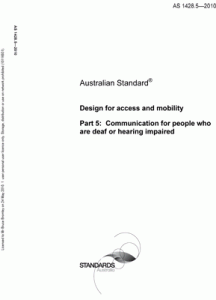The objective of this Standard is to assist in the provision of an environment in which people who are Deaf or who have a hearing impairment are included and can share in information and communicate with all members of the community.
This standard is available from SAI Global HERE

Some 20 children per 10 000 births are born with a hearing loss while another 12 children per 10 000 acquire at least a moderate hearing impairment through accident, illness or other causes before the age of 17 years (Australian Hearing Information Sheet 1S 17.A, Anon 2004).
The causes of hearing loss are many: disease, hereditary factors, accidents (head injury), exposure to loud noise and the ageing process, which are the most common reasons for hearing loss. Acquired hearing loss accounts for the largest percentage of people with a hearing impairment. This is often a gradual process, which, depending on the type and degree of hearing loss, can have significant impact on daily listening, communication and quality of life.
The Standard deals with principles to consider when providing facilities for people who are Deaf or hearing impaired. Factors affecting speech intelligibility and hearing augmentation are also considered, including electromagnetic interference to communication equipment. Assistive listening systems (ALSs) are discussed in depth, including systems suitable for lifts and those suitable for use at security entrances. Auditory, visual and tactile alarm systems for use as early warning systems are also covered. Visual communication, using captions for information, public announcements and on large screens at sporting events and similar situations, is also described. There are sections on communication systems suitable for transport conveyances, telecommunications, and personal response systems. The appendices describe methods of test for assistive listening system equipment and information on audio loop systems together with good acoustic environments.
Good quality communication systems will benefit all people, including those from non-English speaking backgrounds, especially in crowded areas. No one solution will suit all people with hearing loss. The following Table provides a brief overview of the degrees of hearing loss and the most common design solutions to assist with effective communication.
The effects of hearing loss and associated conditions can have a significant impact on the individual’s lifestyle. Attention must be given to providing appropriate acoustic environments that incorporate well-designed amplification and assistive listening systems (ALSs).
Hearing loss often requires a variety of new skills to be learned, e.g., lipreading, communication strategies, and/or sign language. It also requires access to a wide range of assistive technology, including hearing aids, cochlear implants, assistive listening devices and assistive listening systems (ALSs) for indoor areas such as theatres, places of worship, transport terminals, transport conveyances and outdoors. To facilitate lipreading and the use of sign language attention must be given to appropriate lighting and background decor.